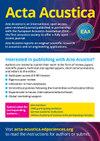Survey method for field measurement of rubber ball impact sound in reinforced concrete apartment houses in Korea – Based on the Korean measurement method
IF 1.4
3区 物理与天体物理
Q4 ACOUSTICS
引用次数: 0
Abstract
The rubber ball impact sound has been standardized by ISO 10140 series and ISO 16283-2 for laboratory and field measurements, respectively. The ISO 10052 standard specifies a survey method for the impact sound measurement using a tapping machine and a rubber ball. This study proposed measurement position for the survey method which is highly correlated with result based on the Korean Standards (KS) and the building regulation of South Korea for engineering method. The rubber ball impact sounds were measured in 79 reinforced concrete apartment houses, which have a centre point and four perimeter points for both exciting and receiving sounds. The proposed survey method was validated for only a specific type of apartment building layout and construction in the South Korean environment. The excitation and receiving points in the perimeter having the most similar characteristics to the results obtained using the Korean engineering methods were first selected. By combining the selected perimeter point and centre point for both the excitation and receiving sounds, the characteristics of each combination were compared with the results obtained using the Korean engineering method. When one excitation point or receiving point in the perimeter was added to the centre point for the proposed survey method, the difference between the measurement result using the engineering and proposed survey method decreased. The standard deviation of the difference between the SNQs of the proposed survey method and the Korean engineering method for measuring the rubber ball impact sound was smaller than 2 dB.韩国钢筋混凝土住宅橡胶球冲击声现场测量方法-以韩国测量方法为基础
橡胶球撞击声已分别通过ISO 10140系列和ISO 16283-2标准,用于实验室和现场测量。ISO 10052标准规定了用攻丝机和橡胶球测量冲击声的测量方法。本研究根据韩国标准(KS)和韩国建筑规范的工程方法,提出了与结果高度相关的测量方法的测量位置。橡胶球撞击的声音在79个钢筋混凝土公寓中进行了测量,这些公寓有一个中心点和四个外围点,分别用于激发和接收声音。所提出的调查方法仅针对韩国环境中特定类型的公寓建筑布局和建筑进行了验证。首先选取与韩国工程方法得到的结果特征最相似的周长激励点和接收点。通过结合选定的激发声和接收声的周长点和中心点,将每个组合的特征与使用韩国工程方法获得的结果进行比较。当在建议的测量方法的中心点上增加一个周长的激励点或接收点时,工程测量结果与建议的测量方法之间的差异减小。所提出的测量方法的snq与韩国工程方法测量橡胶球冲击声的标准偏差小于2 dB。
本文章由计算机程序翻译,如有差异,请以英文原文为准。
求助全文
约1分钟内获得全文
求助全文
来源期刊

Acta Acustica
ACOUSTICS-
CiteScore
2.80
自引率
21.40%
发文量
0
审稿时长
12 weeks
期刊介绍:
Acta Acustica, the Journal of the European Acoustics Association (EAA).
After the publication of its Journal Acta Acustica from 1993 to 1995, the EAA published Acta Acustica united with Acustica from 1996 to 2019. From 2020, the EAA decided to publish a journal in full Open Access. See Article Processing charges.
Acta Acustica reports on original scientific research in acoustics and on engineering applications. The journal considers review papers, scientific papers, technical and applied papers, short communications, letters to the editor. From time to time, special issues and review articles are also published. For book reviews or doctoral thesis abstracts, please contact the Editor in Chief.
 求助内容:
求助内容: 应助结果提醒方式:
应助结果提醒方式:


